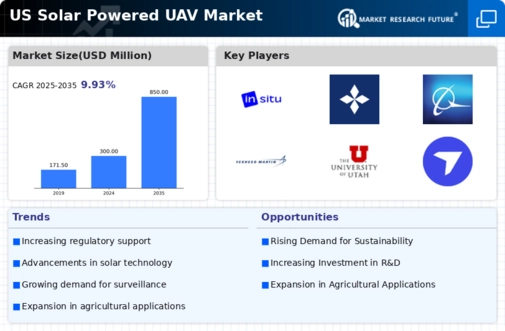Advancements in Solar Technology
Technological innovations in solar energy are significantly impacting the solar powered-uav market. Enhanced solar panel efficiency and lightweight materials are enabling UAVs to operate for longer durations without the need for frequent recharging. For instance, recent developments have led to solar panels that can convert up to 25% of sunlight into usable energy, which is a notable improvement. This advancement not only increases the operational range of UAVs but also reduces the overall cost of ownership. As these technologies continue to evolve, the solar powered-uav market is likely to see a surge in adoption across various sectors, including environmental monitoring and disaster response.
Government Incentives and Funding
Government initiatives aimed at promoting renewable energy technologies are playing a crucial role in the growth of the solar powered-uav market. Various federal and state programs offer financial incentives, grants, and subsidies to companies investing in solar technology. In 2025, it is estimated that funding for renewable energy projects will exceed $10 billion, with a portion allocated specifically for UAV development. This financial support encourages innovation and lowers the barriers to entry for new players in the market. Consequently, the solar powered-uav market is likely to expand as more companies leverage these incentives to develop and deploy solar-powered UAV solutions.
Integration with Smart Technologies
The integration of solar powered UAVs with smart technologies is emerging as a key driver in the market. The advent of artificial intelligence (AI) and machine learning is enhancing the capabilities of UAVs, allowing for more sophisticated data analysis and autonomous operations. This integration enables solar powered UAVs to perform complex tasks, such as real-time data processing and decision-making, which are essential for applications in logistics and emergency response. As smart technologies become more prevalent, the solar powered-uav market is expected to experience accelerated growth, with an anticipated increase in market size by 20% over the next few years.
Rising Demand for Sustainable Solutions
The increasing emphasis on sustainability within various sectors is driving the solar powered-uav market. Organizations are actively seeking eco-friendly alternatives to traditional UAVs, which often rely on fossil fuels. This shift is evident as companies aim to reduce their carbon footprints and comply with environmental regulations. In 2025, the demand for sustainable UAV solutions is projected to grow by approximately 30%, reflecting a broader trend towards renewable energy sources. The solar powered-uav market is positioned to benefit from this demand, as these UAVs offer extended flight times and reduced operational costs, making them an attractive option for industries such as agriculture, surveillance, and logistics.
Increased Focus on Surveillance and Monitoring
The rising need for surveillance and monitoring across multiple sectors is propelling the solar powered-uav market. Industries such as agriculture, security, and environmental management are increasingly utilizing UAVs for data collection and analysis. Solar powered UAVs, with their extended flight capabilities, are particularly suited for long-duration missions, making them ideal for tasks such as crop monitoring and wildlife tracking. The market for UAVs in surveillance is projected to grow by 25% annually, indicating a robust demand for solar powered solutions. This trend suggests that the solar powered-uav market will continue to thrive as organizations seek efficient and sustainable monitoring options.























Leave a Comment